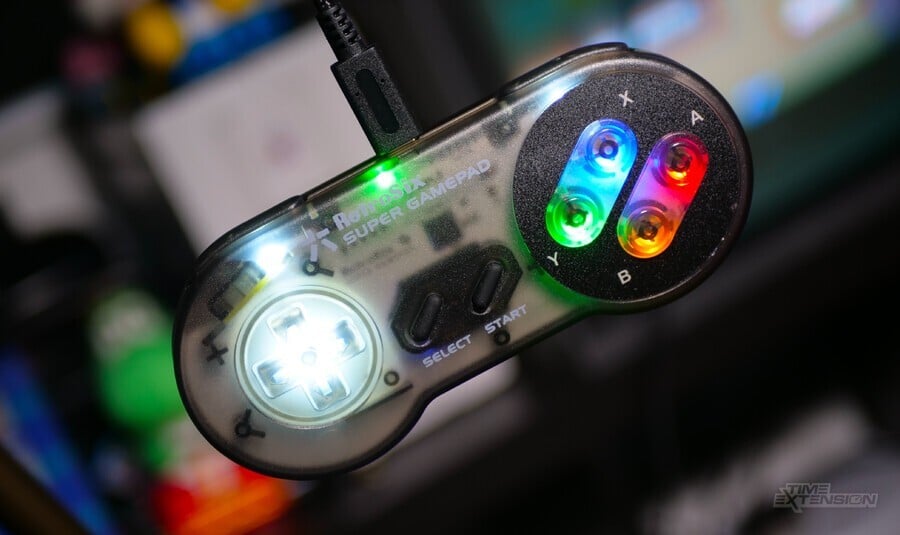
As well built as your typical console controller is, it's inevitable that it will eventually stop working or develop a fault. When you consider that consoles like the SNES and Mega Drive / Genesis are now well over 30 years old and arguably past their expected operational lifespans, it's remarkable that their respective pads still function at all.
With that in mind, you may find yourself in a situation where your beloved (and battered) controller has finally given up the ghost, and you're in the market for a replacement. We've already experienced the brilliance of 8BitDo's replacement SNES controllers, and Retro-Bit also has a solid option on the market in the form of its Legacy16 pad. However, there's always room for more choice – especially when you consider how much affection there continues to be for Nintendo's 16-bit console – so we were keen to check out RetroSix's offering, the Super GamePad.
If you haven't heard of RetroSix before, a little introduction might be in order. Based in the United Kingdom, the company is a lot smaller than the likes of 8BitDo, Hyperkin and Retro-Bit, and is mainly focused on producing kits and components for modding classic systems. The Super GamePad marks something of a shift for the company, as it's a product designed from the ground up by RetroSix to be the ultimate, one-stop SNES pad replacement.
Available in three designs – grey (which looks almost identical to the original SNES pad), clear and clear black – every element of this controller is brand new and designed in-house by RetroSix, right down to the PCB nestled inside. Despite this, the pad is a very close match to the original Nintendo version in terms of ergonomics and feel; the D-pad and buttons are perhaps a little less spongy and more 'clicky' than they are on an authentic SNES controller, but this doesn't impact accuracy or precision when in use.
While the Super GamePad emerges out of its box cordless, it's not a wireless pad. Instead, it comes bundled with a high-quality braided USB-C-to-SNES controller port cable, also designed by RetroSix. Connecting the pad to your console triggers the next surprise – beneath the casing, there are a series of multicoloured LEDs which look especially effective in the clear and clear black models; the ones under the A, B, X and Y buttons are even coloured to match the original SNES button layout. On the non-transparent grey model, the effect is more subtle and there's some minor light bleed through the casing, but it still looks great.
The LEDs can be switched off by holding L + R + X + A and pressing Up (on) or Down (off) if you so wish – with one exception. The green LED at the top of the controller, which shows when it's plugged in, remains on regardless. In another nice touch, your LED setting is persistent and is remembered by the pad even after it's unplugged.
You might assume that, because it has a USB-C connection, it's possible to use the RetroSix Super GamePad with other systems, such as your home computer. However, this isn't the case; connecting the controller to our MacBook via a USB-C to USB-C connection doesn't do anything – the LEDs don't even power up on the pad itself. We tried it with other devices and got the same results. There's a chance that the Super GamePad may be upgraded in the future to include expanded connectivity, but for now, it's only going to be useful if you own a SNES (or a SNES clone, like the Analogue Super Nt).
The lack of a wireless mode might also come as a negative for some people, especially those who are accustomed to the cable-free experience of modern-day consoles (and the experience offered by 8BitDo's retro-themed pads). However, the upshot is that the Retro-Six Super GamePad has very low input latency – and, if you find that the 2.5m cable which comes bundled with the controller is too short, you can always purchase a USB-C cable extender. RetroSix has previously said it is working on a wireless variant of this pad, so if you're really keen on going cable-free, then you might wish to wait a little – although that one might end up costing you a little more.
On the topic of the price, at £30 / $36 / 34 Euros, the RetroSix Super GamePad isn't as cheap as some of its more capable rivals, but if you're looking for a near-direct replacement for your original SNES pad with the lowest possible input latency, then it's a solid choice regardless – and those LEDs, while somewhat of an acquired taste, certainly make this pad stand out from the crowd.
Please note that some external links on this page are affiliate links, which means if you click them and make a purchase we may receive a small percentage of the sale. Please read our FTC Disclosure for more information.
Thanks to RetroSix for sending the Super GamePad controllers used in this review.





